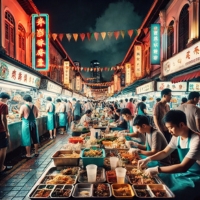Chinatown hawker leftovers consumption. Food waste is a growing concern for urban populations, especially in Chinatown hawker shops where a lot of leftovers are thrown out daily. The economy and environment suffer because a significant portion of the thousands of meals that are provided at these bustling street food shops go uneaten.
Although there are some initiatives to address food waste from hawkers, long-term fixes are still required. Is it safe to share leftover food? In what ways might food production be curbed at hawker stalls? The problems of food waste in Chinatown will be discussed in this article, along with the creative methods that companies and customers are attempting to create a more sustainable future.
Understanding Food Waste in Hawker Centers

Food waste is an inevitable consequence of the thousands of people that visit Chinatown’s hawker centers each day. Numerous factors, including over-preparation, fluctuating demand, and client leftovers, contribute to this issue.
Cultural perspectives on food waste also differ; some people believe in rigorous waste minimization, while others see leftovers as inevitable. Many Asian hawker centers are just starting to use structured waste management techniques, in contrast to certain Western nations that have organized food redistribution systems. A more thorough comprehension of these logistical and cultural aspects is necessary to address food waste at hawker places.
Sustainable Solutions for Leftovers
In an effort to reduce food waste, several Chinatown hawker shops have begun implementing sustainable methods. These consist of:
- Smaller Portion Options: To cut down on plate waste, provide half portions or adjustable meal sizes.
- Creatively Reusing items: Some vendors turn items into new dishes, soups, or stocks.
- Food Redistribution Programs: A number of programs currently gather extra food and give it to food banks and nonprofit organizations, guaranteeing that excess food helps people in need rather than ending up in the trash.
- Composting: To support a circular food economy, some hawkers work with composting facilities to turn organic waste into fertilizer.
- Innovations in Food Recycling & Repurposing
As technology advances, new approaches to effectively addressing food waste are being developed. These consist of:
- AI-driven Waste Management: Intelligent AI systems can reduce overproduction and enhance inventory control by predicting food demand.
- Automated Food Sorting: AI-powered sensors help separate leftovers for redistribution, composting, or other uses.
- Food upcycling firms are startups that turn food waste into new edible products including snacks, sauces, and even beverages.
By ensuring that food surplus is used more effectively, these solutions greatly reduce landfill contributions.
Consumer Role in Reducing Leftovers
In order to reduce food waste, hawker centers depend on both customers and vendors. Here are several ways that both residents and visitors can help:
- Order Just What You Need: Paying attention to portion sizes helps you avoid wasting money.
- Share Meals: If the portions are substantial, think about sharing them with other people.
- Encourage Waste Reduction Initiatives: Some applications and services make it simpler for users to get involved in waste reduction by connecting them with excess food at a discount.
- Bring Reusable Containers: You can avoid throwing away leftovers by packing them to go if you couldn’t complete a meal.
Customers can actively contribute to the development of a more sustainable food culture in Chinatown by accepting responsibility.
Legal & Health Implications of Leftover Consumption
Even while initiatives to redistribute food are increasing, how leftovers are handled is heavily influenced by legal and health concerns. Among the issues are:
- Food Safety Regulations: To avoid foodborne infections, several governments impose stringent rules on the redistribution of food.
- Liability Concerns: Apprehensions about being held accountable for any health-related problems make some suppliers reluctant to contribute leftovers.
- Government Policies: Some areas have passed laws that shield food donors from legal action while guaranteeing that food safety regulations are followed. Adopting comparable regulations will help Chinatown hawker centers promote food redistribution without running afoul of the law.
- Future Trends in Sustainable Hawker Dining
Hawker dining’s future is probably going to include:
- Zero-Waste Dining Concepts: More vendors are expected to employ zero-waste methods, such as composting and making the most of materials.
- Changes in Policy: Governments everywhere are increasing pressure on governments to pass legislation that mandates the reduction of food waste, which may also apply to hawker centers.
- Global Influence: Chinatown hawker stalls may incorporate international best practices into their operations as sustainability trends continue to influence the food business.
Hawker centers can preserve their rich culinary traditions while moving toward a more sustainable future by adopting these trends.
FAQs
Q1: How are the leftovers from Chinatown hawker centers handled?
A lot of hawker centers reduce waste by using composting initiatives, redistributing food to charities, or discarding extra food.
Q2: Does the redistribution of food from hawker stalls have any legal restrictions?
Regional rules pertaining to food redistribution differ. Some governments have more stringent laws pertaining to food safety, while others promote it with liability protections.
Conclusion
Chinatown hawker leftovers consumption. Food waste is a growing concern for urban populations, especially in Chinatown hawker shops where a lot of leftovers are thrown out daily. The rich culinary traditions of Chinatown hawker centers and the increasing need for sustainability are at odds. Vendors, customers, and legislators all share responsibility for reducing food waste.
As to the future of Chinatown hawkers eating leftovers, bright, thanks to technological advancements, conscientious consumer behaviour, and supportive laws. These ideas can be adopted in an attempt to build a more waste-free and sustainable dining culture in one of the earth’s most famous culinary hotspots.




